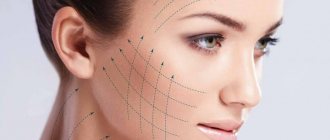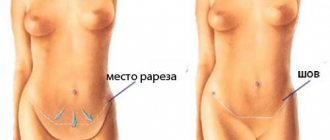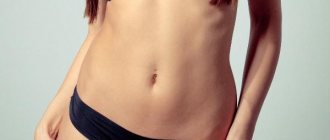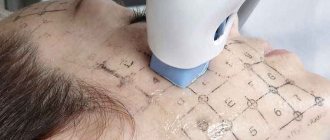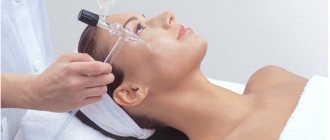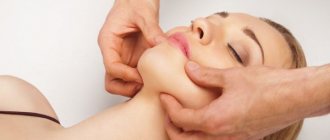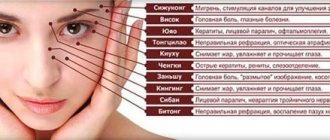Most patients with slight or moderate ptosis of the skin of the body do not decide to have a surgical lift because of the long scars that the operation leaves. Lifting problem areas (sagging skin of the thighs, arms, buttocks, abdomen) with mesothreads is the best and practically the only solution for women who dream of tightening the skin on the abdomen, inner thighs or shoulders without surgery.
Body lifting with mesothreads gives impressive results, while the procedure is completely safe and painless and does not require rehabilitation.
Bio-reinforcement of the body using mesothreads, or thread lifting, is a unique technique that came to us from South Korea. It allows you not only to solve the problem of ptosis and correct body contours, but also to cope with the manifestations of cellulite, make the skin denser and more elastic, get rid of unevenness and, if necessary, correct the results of liposuction.
Mesothreads are created from a completely natural material - polydioxanone, which is involved in the metabolism of young healthy skin, so this substance does not cause allergies or other unpleasant consequences. Until recently, lifting using threads was used by cosmetologists only to eliminate age-related changes on the face, but practice has shown that the use of biothreads to tighten the skin of the body (with a diameter of 0.3 mm) allows doctors to effectively lift problem areas without surgery, without leaving scars or swelling and bruises.
Another advantage of mesothreads is their ability to have a tonic effect on tissue, which allows you to achieve the maximum effect of skin tightening. When threads are introduced, a kind of supporting frame is created, which improves the contours of the body, eliminating sagging skin.
Need a consultation?
How effective are mesothreads in the abdomen for skin tightening and weight loss?
The introduction of mesothreads into the abdomen is carried out using special steel needles, characterized by increased strength and minimal thickness.
This is how mesothreads are inserted into the stomach
The length of the threads is from 3 to 9 cm, and the thickness is 1 mm. After insertion, the fibers intersect with each other and are woven into a kind of mesh. They are fixed under the skin and correct the shape of the abdomen. At the patient’s request, the doctor can inject the material into other areas of the body: face, neck, décolleté, chest, buttocks, or inner thighs and arms.
The material is stored in subcutaneous tissues from six months to 9 months. During this period, collagen and elastin fibers are formed around them, which form a supporting frame. Thanks to this, the stomach becomes toned, elastic and flat. After 6-9 months, the threads dissolve, breaking down into carbon dioxide and water. They are eliminated from the body, but the effect they create remains.
The material is stored in subcutaneous tissues from six months to 9 months. During this period, collagen and elastin fibers are formed around them, which form a supporting frame. Thanks to this, the stomach becomes toned, elastic and flat. After 6-9 months, the threads dissolve, breaking down into carbon dioxide and water. They are eliminated from the body, but the effect they create remains.
Indications and contraindications
A tummy tuck with mesothreads is a safe method of body contouring, which is indicated in the following cases:
- age-related skin aging;
- sagging belly after childbirth;
- decreased elasticity of the abdominal area due to chronic diseases, injuries, surgery or hormonal disorders;
- stretching and protrusion of the abdomen due to weight gain.
The procedure is contraindicated in the presence of acute and chronic infections, cancer, pathologies of the circulatory and endocrine systems, infectious and inflammatory skin lesions, elevated temperature and weak immunity. A facelift is not recommended for women who are carrying or breastfeeding a child. Mental and autoimmune diseases and the tendency of the skin to form hypertrophic and keloid scars are also contraindications for a facelift.
Patient preparation
Before the doctor begins to perform his work, the patient must undergo preparation for it:
- be examined by a therapist to identify hidden pathologies or by your attending physician if you have chronic diseases;
- visit a specialist who will directly deal with the tummy tuck - he will determine the places where the threads are inserted, their number and length;
- 3 days before the procedure, do not treat the skin of the abdomen with any cosmetic products.
It is imperative to inform the doctor about the schedule of the menstrual cycle - during monthly bleeding, a woman cannot perform any manipulations in the abdominal area , the procedure will simply be postponed for some time. And one more nuance - the introduction of threads is considered a painless procedure, but if the patient has very increased sensitivity of the skin on the abdomen, then local anesthesia (gel or ointment with lidocaine in the composition) will be selected for him.
Types of threads used for tummy tuck
Mesothreads
To improve the condition of the skin, doctors use 3 types of mesothreads for tummy tuck:
- Smooth (linear) mesothreads. Such threads have a uniform structure. They are a combination of polyamide, silicone and polyurethane, which are intertwined. Their length varies from 25 to 90 mm. The threads are fixed to the bone tissue, making them effective even with severe sagging skin. The size and amount of injected material is determined by the thickness of the skin and other individual characteristics. The material is introduced into the subcutaneous layer through an incision, but thanks to local anesthesia, the procedure is painless.
- 3D mesothreads. This type of material is ultra-thin, so there is no need to make an incision to insert it. The doctor uses a special cannula with a blunt tip that passes through the tissue without causing damage. Thanks to the flexibility of the cannula, the threads are introduced into all layers of the skin, creating the effect of three-dimensional 3D modeling. This type of thread is distinguished by a soft and gentle action, however, the effect will be noticeable only with mild changes.
- 4D mesothreads. The material of these threads consists of polydioxanone and is inserted under the skin with flexible needles, the thickness of which does not exceed 0.1 mm. After the procedure, no traces remain on the patient’s skin, and compatibility with human tissue eliminates the possibility of allergic reactions. The needles are removed, and the threads dissolve on their own after 6-9 months.
- Spiral threads with serifs. The difference between these mesothreads is that they have a spiral shape and are equipped with special notches, with the help of which the material is securely fixed in the tissues. When inserted, such mesothreads are stretched, but then return to their original form. The effect of this procedure is quite strong, so it is often prescribed to women who have recently given birth.
- Combined. They are made of polypropylene and are complemented by small cones made of lactic acid. The last component stimulates increased collagen production, which creates a lasting anti-aging effect.
- Aptos. This material is made from caprolac or other substances that are harmless to the body. Along the entire length of the thread there are special notches that cling to soft tissue and move the skin in the desired direction. Thanks to this, the skin looks younger. Another advantage of these mesothreads is that they are inserted to a shallow depth and do not touch nerves and blood vessels.
The listed types of mesothreads can be absorbable or non-absorbable. The latter are made on the basis of medical polypropylene - a substance that is biologically compatible with tissues, but cannot disappear on its own. The polypropylene material remains under the skin forever and provides a tightening effect for about 5 years.
Before the procedure, you must undergo a full medical examination and consult a cosmetologist. This is necessary in order to select the right material and avoid possible complications.
How the procedure is performed
An abdominal lift is carried out in several stages:
- The patient receives a doctor's consultation. The specialist collects information about the patient’s health status, learns about previously performed procedures and determines the skin type. Based on the information received, the specialist makes a decision on the advisability of the procedure (if there is at least one contraindication, the lift is prohibited).
- The doctor selects the type and diameter of the needle and mesothreads. If necessary, correction is carried out using different types of materials. This helps to achieve maximum effect. Patients under 40 years of age are injected with material that resolves on its own. For patients between 40 and 50 years of age, doctors inject non-absorbable material. If the lift is performed on a person over 50 years old, small incisions are allowed.
- The specialist prepares the patient’s skin for tightening: cleanses, treats with antiseptic agents and applies a cream that eliminates pain.
- After the preparatory stage, the procedure is carried out. The cosmetologist marks the injection area, and then inserts mesothreads under the skin using a guide needle. After insertion, the thread is separated from the needle and remains in the patient's body.
After the procedure
The procedure is performed only on an outpatient basis and lasts up to 1 hour. It is important not to confuse this type of abdominoplasty with a lift.
Advantages of Aptos threads
There are only two obvious advantages:
- They solve the problem even with excessively sagging skin on the abdomen - the result is visible almost immediately and lasts for a long time. As you “wear” the threads, the general condition of the skin improves, it becomes firmer and more elastic. The procedure with Aptos threads can be combined with other cosmetic procedures, which will only enhance the positive effect.
- The insertion of threads is painless and safe - there is no risk of infection with hepatitis, human immunodeficiency virus, or papillomavirus. The skin of the abdomen is practically not injured, so the risk of scar formation is reduced to a possible minimum.
Unfortunately, there is a significant drawback to this medical procedure – the cost of the threads.
Since the patient has to pay for each Aptos thread, with large areas for the doctor to work, the amount is indecently high. But this unpleasant moment is offset by the indicated advantages and always a positive result. Expert opinion
Yulia Mikhailova
Nutrition expert
Experts warn that achieving the described result and the absence of undesirable consequences is only possible if the procedure is carried out by an experienced doctor in compliance with the rules of hygiene and manipulation technology.
Recovery period
If the specialist performing the tummy tuck has performed the procedure correctly, there are minimal or no negative consequences, but this depends on the individual characteristics of the body. It is important to follow your doctor's recommendations during the rehabilitation period.
What not to do after the procedure
The recovery period after a tummy tuck with threads lasts no more than 7-12 days. To make recovery faster, the patient must follow a number of recommendations:
- In the first hours after the procedure, you should not use tobacco products.
- In the first 3 days, doctors recommend avoiding visiting the sauna, bathhouse, gym, swimming pool and solarium. The list of prohibited procedures includes taking a hot bath or shower.
- Limit any contact with the injection site: do not massage it, apply a heating pad or cold compresses to it.
- In the first week, it is important to avoid strenuous exercise. If this is not done, the threads will move and the effect of the procedure will not be strong enough.
- In the first month, you should avoid sunbathing, physiotherapeutic procedures and massage. To protect the skin, it is recommended to use creams with UV filters.
Salty, spicy and fatty foods, coffee and alcoholic drinks should be consumed in limited quantities. You can care for your skin using purified water and soap, foams and other cosmetics that do not contain alcohol or abrasive (exfoliating) substances.
If pain appears at the injection site, non-steroidal anti-inflammatory drugs can be used. These include Ibuprofen, Paracetamol, Ketanov, Aspirin, Nimesulide. Taking medications must be agreed with your doctor. Uncontrolled use of such drugs can lead to new disorders.
Possible complications: how to avoid them
Possible consequences of bioreinforcement that do not need to be feared:
- Bruises that appear due to damage to small vessels during thread insertion. If blood clotting is poor or during menstruation, hematomas may form. Both go away in 7–10 days; if you use restorative gels and ointments, you can recover faster.
- Swelling lasts for 2–4 days, but it is almost invisible on the body. They go away on their own.
- Violations of facial expressions. Observed for several hours after the procedure until the anesthesia wears off. In rare cases, a persistent disorder lasting longer than 3–4 days is observed when swollen tissue compresses the nerve endings. In this case, you need to consult a doctor.
- Hypercorrection. Doctors often consciously lift the tissue above its natural position, because while the swelling goes down, the skin itself will lower under the influence of gravity. After 7-10 days, the problem area usually looks completely natural.
In what cases is medical intervention necessary:
- Allergy to anesthetic and (or) suture material. Antihistamines are suitable as first aid. The next step will most likely be removing the threads.
- Seals, pits and bumps appeared in the reinforcement area. They are formed as a result of thread displacement when the fabric is unevenly distributed along the seam. Sometimes they occur at the points where the needle enters and exits. For treatment you need to see a doctor - they will not go away on their own.
- Inflammatory process in the reinforcement zone. Most often it happens because simple sanitation rules are violated in the treatment room. At the initial stage, antibiotics will help to cope with the infection; in case of extensive abscesses, the threads are removed.
- Tightness of fabrics. Occurs if, when fixing the threads, the doctor applied more effort than necessary. The texture of the fabric can be restored by massage - if it is reinforced with a smooth thread. In difficult cases, the thread is removed.
- Thread migration. It can be observed six months to a year or longer after the procedure. The problem occurs due to the fact that the threads are displaced from a given line and move in the subcutaneous layer. In such cases, the implants are always removed.
- Thread contouring. If the implants show through, there is only one reason - a violation of the technique. The threads are not installed in the upper layer: most often in the subcutaneous fatty tissue, less often in the dermis and SMAS (muscle layer). The tip of the thread or the entire thread may appear; depending on the degree of the problem, either a fragment or the entire implant is removed.
By the way, the removal of threads itself causes a lot of concern among patients. For some reason, it is believed that when implants are removed, the tissues are torn, and then scars remain for life. Doctors say that in fact, several punctures are made in the area of the reinforcement, the thread is cut and pulled out using a hook or needle with a curved tip. If for some reason the patient is dissatisfied with the result and wants to remove the threads, then it is advisable to do this no later than 2 months after the procedure, until the stitches are completely healed.
Surgeon D. A. Gruzdev about thread lifting - video
Side effects
A thread tummy tuck may cause side effects such as bruising and swelling. Even minor damage to the skin can cause this reaction, and when combined with stress, the effect can be intensified. To relieve swelling and bruising, use absorbable ointments and cooling compresses. Avoiding alcohol, spicy, fatty and salty foods, as well as limited consumption of salt, a substance that can retain fluid in the body, will help reduce side effects to a minimum.
If during the procedure the doctor made a mistake (used untreated instruments or inserted a needle into an inappropriate area), consequences such as:
- transmission of mesothread through the skin;
- the formation of a fold that cannot be removed independently;
- change in the appearance of the abdominal area (the abdomen looks asymmetrical);
- the appearance of a tubercle at the injection site;
- local or general infection.
In case of complications, you should contact the specialist who performed the procedure. To avoid unpleasant consequences caused by the unprofessionalism of the master, carefully choose a cosmetology clinic. Do not contact specialists who see patients at home or in poorly equipped premises.
Recovery
In order to eliminate such unpleasant consequences as the cutting of threads and the formation of depressions and bumps, infection of puncture sites and swelling of the skin, the patient must follow the following rules:
- eliminate physical stress on the hip joint;
- treat puncture sites with antiseptic agents;
- apply cold to the buttocks in the first days after the procedure;
- Avoid procedures using heat (baths, baths, saunas).
The effect of tightening and increasing the volume of the buttocks with threads lasts on average for one year.
Read more
